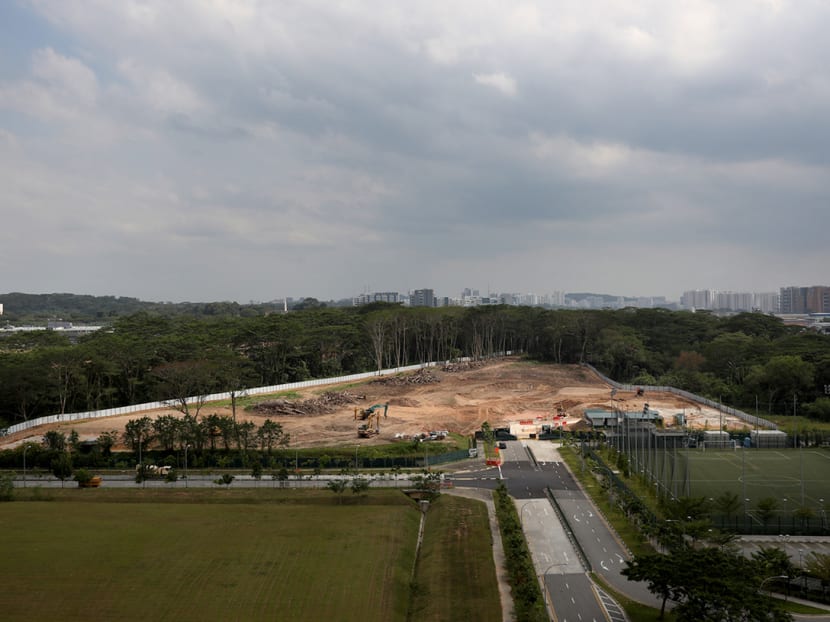Explainer: The history of the cleared Kranji woodlands, and what could be found there
SINGAPORE — A forested parcel of land around Kranji Road that was erroneously cleared by a contractor was not located near any sensitive nature areas, said state-owned industrial property developer JTC Corporation.

Aerial view on Feb 17, 2021, of a forest parcel in Kranji that JTC said its contractor had “erroneously” begun deforesting.
- The affected site in Kranji was once land belonging to the KTM railway operator
- When the land was returned to Singapore, it consisted of scrubland vegetation, before it was dominated by Albizia trees
- JTC said it is not near any sensitive nature areas
SINGAPORE — A forested parcel of land around Kranji Road that was erroneously cleared by a contractor was not located near any sensitive nature areas, said state-owned industrial property developer JTC Corporation.
In 2008, it was dominated by scrubland vegetation, and since then non-native Albizia tree regrowth had taken over the area, said the agency at a news conference on Monday (Feb 22).
Scrubland generally refers to open habitat that consists of small trees or bushes.
The affected land lies within a 25ha site in Kranji, which was set aside for the development of the Agri-Food Innovation Park (AFIP). It is part of the 500ha Sungei Kadut Eco-District.
The erroneous tree clearing involves 4.5ha out of the 11.9ha that has been cleared so far. Another 13.1ha of greenery is still undeveloped and all site works have stopped.
TODAY takes a look at the background of the site, as well as the biodiversity of the area.
FORMER KTM LAND
A portion of the affected site was once part of the railway line owned by Malaysian rail operator Keretapi Tanah Melayu (KTM) from the days when Malaysian trains ran to Tanjong Pagar.
A JTC spokesman said that Singapore had negotiated for the return of the railway land to meet the country’s land-use needs. It was handed back to the State on July 1, 2011 after the KTM ceased running trains through Singapore.
Back then, the site still consisted of disused scrubland. However, as it was left unmanaged, Albizia trees soon sprouted and dominated the area.
Albizias are one of the fastest growing species of trees in the world, but they are also prone to collapse due to their brittle wood structure and shallow root systems.
PLANS FOR THE SITE
As part of the review of the land that was returned, 24km of Rail Corridor from Woodlands to Tanjong Pagar was retained as a green corridor for nature, leisure and community users, said the spokesman.
Meanwhile, other sites along the railway line were earmarked for Singapore’s development needs, including the affected area in Kranji, which the spokesman said was surrounded by scrubland and industrial users.
As part of its plans for the AFIP in 2019, JTC, together with the National Parks Board (NParks), backed the plan to retain the former KTM railway line as a green corridor.
Doing so would allow them to set aside 40 per cent of the site for green cover by having an additional 15 to 20m green buffer on either side of the 45m to 60m wide green corridor.
This green cover, said the spokesman, would provide ecological connectivity between the Sungei Pang Sua and Sungei Mandai.
These two rivers lead to the Mandai Mangrove and Mudflat, which is a rich feeding ground for migratory birds.
The spokesman added that NParks intends to retain the natural vegetation along the banks of the rivers, and further enhance it with other native plants.
A HOME FOR BIRDS
An environmental impact assessment was not deemed necessary for the development works at the Kranji site to proceed given it was dominated by scrubland vegetation in 2008, and then Albizia trees.
“It is also not close to any sensitive nature areas,” said the JTC spokesman.
Still, a biodiversity survey was conducted as NParks was concerned that the construction of drainage areas could cause pollution to Sungei Pang Sua, said Dr Leong Chee Chiew, commissioner of parks and recreation at NParks.
There was also concern at NParks that the clearance of vegetation for the drain would affect the health and wellbeing of animals in the area, said Dr Leong.
While the news conference did not specifically address what animals can be found within the area, the Nature Society Singapore (NSS) had previously conducted its own study of the area.
In The Green Rail Corridor, published by NSS in 2019, the society said a rapid survey from the green corridor yielded 47 species of birds that could typically be found in a variety of areas such as the forest, scrublands, or wetlands.
NSS said these birds are of both the resident and migratory variety, and account for about 12 per cent of Singapore’s total recorded birds.
Notable species include the changeable hawk-eagle, grey-headed fish eagle and the crested serpent eagle. All three birds of prey are listed in the Singapore Red Data Book, which is a publication of endangered plants and animals found across the island.








